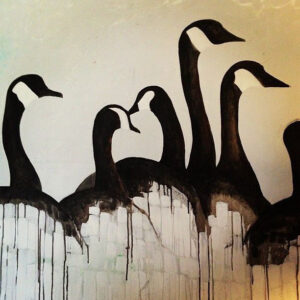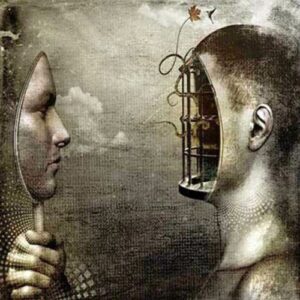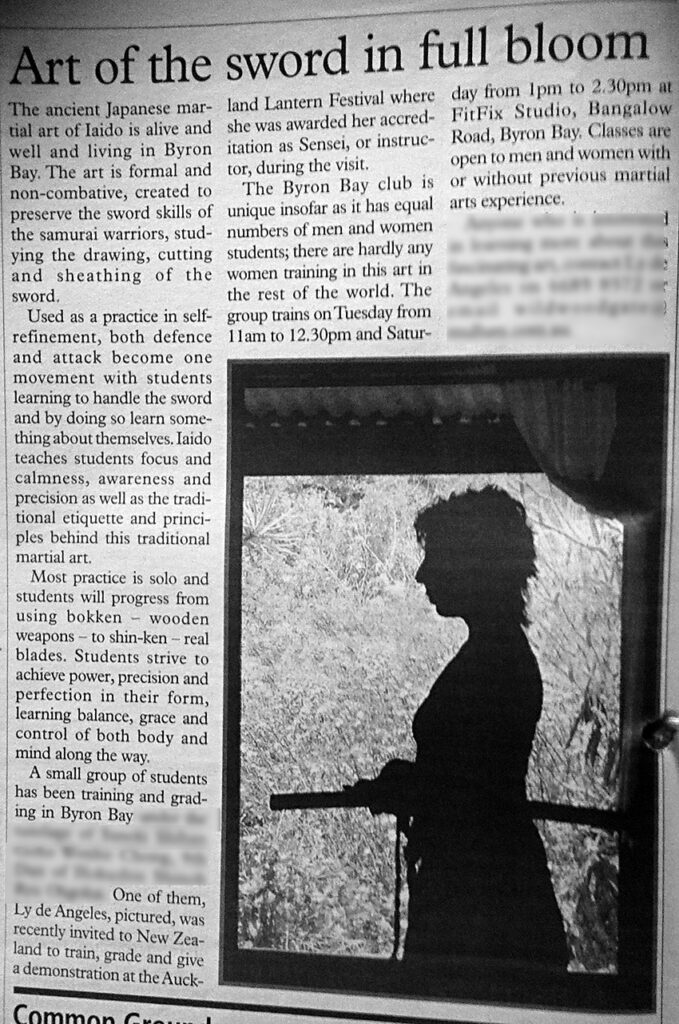WOMEN’S WORKSHOP 2025/SANDY BAY TASMANIA

Realigning from disassociation
This is an initial women-only workshop that will also be introduced to men, depending on interest. Experience has shown that in a group scenario of inter-gender humans behavior changes due to social constructs. I wish it was not so but, as the saying goes: if wishes were horses beggars would ride.
INTRODUCTION
- Lore (Ly de Angeles) has trained in martial arts for most of her adult life. She is a 3rd Dan sensei of a Shinoh Ryu Iaido, the art of the Japanese sword, its practice, silence, meditation and wisdom. SEE HERE. Kaisho of the Byron Bay Dojo de Angeles relocated to Melbourne in 2013 to engage in post-graduate research. She initiated Clan Fianna, a club specifically for women, using staff (jo) fighting techniques, and also is practiced in Hapkido, MMA and Aikido
- She explains: Many people I have met through my work over the decades, including me, have carried shame and guilt pertaining to what are, essentially and often, injustices that stem from some religious morality or political/social ideology, and so disassociate and assume a role either expected or demanded. We render ourselves silent with the coping mechanism of perceived normalcy, while harbouring, deeply, the anguish of that first rejection or confusion. This, I know, is the cause of much illness and tragedy. The need to be accepted is primal; belonging. Being cast out is the dread of most animals as there is no safety in isolation, rendering them open to predation. Isolation, by the way, is different to aloneness and is also different to loneliness.
ON FREEDOM
WILD GEESE (the title based on a poem by Mary Shelly) is a program of transformation. We draw, firstly, on the story of Fight Club, the book by Jack Palahniuk. The movie of the same name, featuring Ed Norton, Brad Pitt and Helena Bonham Carter, follows the desperation of an anxiety-ridden man who cannot sleep, is trapped in a pointless, futile, unrewarding job, lives away from earth in a high-rise apartment and can’t feel. He has, without intent or conscious choice, switched off his true responses. Ultimately a futile, unconscious survival mechanism, the result of self-suppression &/or the need to rage against actual or perceived injustice. He insinuates himself in self-help groups to which he has no relevance. Perhaps. WILD GEESE understands this as an overwhelming social anxiety.
DISASSOCIATION

We all do it. Sometimes for a lifetime.
Vilification of innocence, based on an enforced, often unconscious, often political or ideological, morality code, is at the core of both human anxiety and human cruelty. And when pressure becomes overwhelming the release can be catastrophic. That release can be expressed externally in countless abusive or complaining ways but can also implode within the person, to themselves. Often eventuating in depression, self-harm, mental instability, perplexing disorders; perpetuated cruelty, the fracturing of health and often suicide.
Have you known the desperation of not being heard? That one time would have been enough to form what’s known as a cascade effect.
DEEP LISTENING
As a linguist, etymologist and writer de Angeles was initially captivated by a lecture by Jon Young [1] and what he learned, from the Kalahari, on mind-mapping. Knowing the trade language (lingua franca) of the current era is Anglish, and also being aware of the predominance of religious and cultural misinformation within everyday parlance and writing, she has doggedly—at times facing vehemence and hostility—trained mind and mouth to speak without contrivance. The effect would have crushed her had she been younger, still seeking to belong, or had had what she calls a “normal” life.
DEEP LISTENING requires putting ourselves aside while we listen. Putting away the need to either empathise, resolve or add opinion to the voice of another. To emphatically hear what is said and let it flow untrimmed by righteousness or even shared experience.
We all hide a memory of shame, resentment, guilt and blame. We don’t want them. Liberation, however, until WILD GEESE, usually requires working with a potentially biased and life-limited, academically trained psychologist, potentially expensive, analysis techniques (fill in the gaps…), or spiritual bureaucracy. To the detriment of wildness and lived experience.
PHYSICALITY
WEEK1:
- you will be asked to make a simple object, but you will be guided. The task is simple, yet physical.
- You will participate in a neural synapsis alteration which sounds complicated but isn’t. It’s a process that switches off the left brain hemisphere amygdala and re-routes to the right brain, where creativity and self-awareness without analytical or learned judgements tend to cloud individuality—occasionally called ‘monkey brain.’ (although I doubt other simians have religion and ideology to trap them).
- You will be given specific body-language-reading techniques.
- One of you, only, will tell the first ever experience of being shamed or guilted and the others will listen and quiet their own minds.
Ensuing weeks will involve each participant telling their story and unlatching the cage door.
REASONS for 1
(de Angeles explains):
Recently I worked with an online group attending sessions via Patreon. I provided explicit instructions on the making of a simple wooden object. The participants were initially at a loss as to how to do so. This is post-c*v-d, and social media, devastation. The realisation that hand and eye are forgetting the capacity for the quiet, meditative skills of making that many of us, as elders, once took for granted, jolted me into an awareness of what I didn’t know; what I needed to teach.
It is important, also, to understand that approximately 80% of all communication is body language. WILD GEESE suggests each participant take note of what could be an unconscious descent into despair simply due to how one sits. The physicality of this work can break stifling neural and muscle-memory patterns. This is called ‘a level of insight’.
REASONS for 2:
The Jesuit saying give me a child till he is 7 and I’ll show you the man, indicates that mind control from infancy cannot be reversed. To a degree that is factual. We are then trapped by parameters, or cages, and are rarely provided freedom. It takes deep work to transcend the bindings and lies we often adhere to regarding religion, gender, academic information, and socially/culturally condoned behaviours, despite them destroying joy and spontaneity. Insight is the realisation that our brains are malleable, and that neuroplasticity is an actual thing. We can, literally, change our minds.
WHAT NOT TO DO
WILD GEESE advises that all religious constructs, ideologies and seeming spiritualties hinder this process. It is not our intention to censor anyone, rather to provide an uncluttered space. No one is left behind.
ONCE IN A LIFETIME–BACKSTORY
In my early twenties (1970s) I began nursing training. I was assigned nightshift at a terminal hospital in Sydney. I learned to ask the patients, in what is called the Dead Zone—three in the morning—to tell me the one thing of which they had always been ashamed but had never spoken of. Those were many years before my profession as a tarot consultant, that also required absolute privacy and anonymity for the seeker.
It wasn’t until I saw the movie Fight Club that I began saying to fearful clients What’s the first rule of Fight Club? Most knew the answer (you don’t talk about Fight Club) because all other metaphors lean towards something cloistered and confessional, and I refuse them. In this way each individual is responsible for the information recorded by me, for them, of events yet to happen. It is also the reason that, for that specific work, I have never advertised; have never needed to.
If, once in a lifetime, we are able to tell of when we were first shamed, first indoctrinated into the fear of consequences, without aware explanation from the accuser: shut up, shut down, shut in, shut out or shut away well…
WILD GEESE is necessary. If only once. Not only for the speaker but also for the listener. To be silent in voice and mind, or to hear our inner communication on the subject being heard, is to be self-aware. Is to respect. In this we are able to consciously alter the synaptic wiring of our brains. We can change.
EARTHING
WILD GEESE requires barefootedness. Unless the weather is likely to cause frostbite. Earthing is proven, scientifically, to calm anxiety and to remind us of belonging. See THE EARTHING MOVIE and persevere past what you might, initially, think is just some new agey hocus pocus
THE DISEASE OF AFFLUENCE
I heard it said, recently, by a healer woman of the Amazon that people from the so-called west, suffer a disease of affluence. No one will ask you to relinquish what you have worked for, but we will discuss the acquisition of stuff, as stuff is the dilemma of the current era. Not simply the desire to possess stuff, but the inability to consider what happens to stuff after it is discarded.
SHOW DON’T TELL
December of 2023 I was asked to be part of an Iaido demonstration at a local park. Out of respect to a different tradition I was quiet. Respectful. The sensei put time and effort into preparing an exhibition of information, armour and weaponry associated with his school but no one, amongst the crowd gathered for the day, took any notice. We were all in the uniform of the club: hakama, gi, obi, with swords (training, not sharp) and bokkens.
Sensei asked me to square-off opposite him to demonstrate a kata (sequence). I prepared, as did he. Then I ran. I ran all around the oval. I had not warned him I would do this but I could sense, firstly his confusion then, as people began to take notice, his joy.
THE POWER OF SHOW-DON’T-TELL
When the demonstration was over I was confronted by three teenage girls, a bit like something slo-mo out of the show Charmed. They were smirking, despite whatever else was in mind.
“So what’s with the funny outfit?” said the beautiful one in the middle. Instead of answering I drew my sword, in its saya (sheath) from its obi (wide wrap-around belt), held it towards her on the palm of both hands, curve of the blade towards me. She was confused but held out her hands and took it.
I placed my hands to the outside of both of hers, my right hand on the tsuba (hilt). “Do you know why I hand it to you like this?” I asked. She and the others were embarrassed but hid it well. I pulled the sword halfway from the saya (scabbard) to demonstrate that the blade side of the weapon was directed at me. Then I came close to the blade to demonstrate that, had I handed it to her the other way, I could easily have sliced her. I did not require the use of words.
I asked her to drop the saya. I showed her how to hold the tsuba with the kissaki (the very tip of the sword) pointed at my throat. I was a meter from her. “Don’t lose me,” I said. I stepped a meter to her right. She didn’t. She was confused. I took up the original position, took hold of the kissaki and brought it to touch the soft part of my throat, maintaining eye-contact. “Don’t lose me,” I whispered. I moved again. She stood still, again, confused.
I again stepped directly in front of her and said quietly, “bend your knees.” She did. Her weight was then directly over her hips. “Don’t lose me,” I said. I moved. She moved. I moved, she moved. No more than three minutes passed. She understood.

Then I showed her how to put the sword back into the saya correctly. She did so. I held out my hands, palm up and she placed the weapon onto them. Correctly. I gave a little bow. She gave a little bow. “A broom handle,” I said. “Anything.” She nodded, her eyes never leaving mine. “No one can get close if you don’t want them too.” And I turned to leave.
The other two girls asked if they could have a go. I said, ask her, directing them to the young woman I had just trained. After they went away another three came to me and said can you show us. “Ask her,” I replied, directing my attention to the first girl in the distance. Two more lots came. They said the same, I said the same. The girl who now knows what to do looked my way from way off. It was enough.
WORD MAGIC, SILENCE MAGIC
Words can be blahblah. Trying something. Manipulating, soothing, educating, hurting. Filling the air when unnecessary. Trying to be important. Quietly, sometimes, asking for help. What, then, is silence?
In WILD GEESE both techniques take on almost an imperative.
[1] https://www.jonyoung.org/
